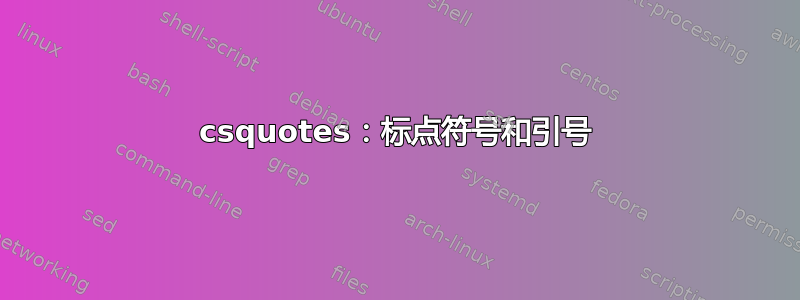
csquotes根据序言中指定的语言自动在引文中包含或排除标点符号。这可以通过类似\DeclareAutoPunct{.,;!?}etc 的命令单独调整。
英国示例:“这是一个引言”。
美国例子:“这是一个引言。”
我现在设计了一个newcommand将引文包装成不同引号符号的程序。为了回答这个问题,我们假设这个例子是这样的:
自定义示例:“这是一个引用”。
我这样做只是按照以下方式newcommand:\newcommand{\strangequote}[1]{°#1°}
这当然不会移动引号内或外的标点符号。我可以更改命令使其移动吗?我如何设计一个命令
还关注
\DeclareAutoPunct{.,;!?}(以便我全局选择全部我的引文是否包含或排除标点符号)或允许我单独选择
strangequote是否包含标点符号。
csquotes' 命令能\MakeForeignQuote有帮助吗?
澄清:我确实想使用这个命令此外到设置英国或美国引号的正常命令(enquote或)。textquote
(撇开小问题不谈:我从来没搞清楚过 quote 命令和带有“c”的 quote 命令之间的区别,例如,\textquote和之间\textcquote)
答案1
我从来没有真正用csquotes尾随标点符号完成我的命令,所以我希望其他人能回答。但是,使用\@ifnextchar,你可以做一个穷人的实现。它可能失败的地方在于尊重\spacefactor,但也许其他人也可以指出我的黑客可以改进的地方。无论如何......
\documentclass[12pt, oneside]{article}
\usepackage[british,american]{babel}
\usepackage[autostyle=true,autopunct=true]{csquotes}
\parindent 0pt
% default spacefactors (nonfrenchspacing):
% 1000 = normal space token
% 1250 = after comma -\
% 1500 = after semicolon > all 3 treated as if 1500
% 2000 = after colon -/
% 3000 = after period, question mark, exclamation mark
\makeatletter
\def\preservesf#1#2{#1}% preserves spacefactor and gobbles punctuation ..?
\newcommand\sqa[1]{%
``#1%
\@ifnextchar.{.''\preservesf{\spacefactor=3000\relax}}{%
\@ifnextchar,{,''\preservesf{\spacefactor=1500\relax}}{''}}%
}
\newcommand\sqb[1]{% <-- strictly speaking, unnecessary.
`#1% instead of defining this command, do
\@ifnextchar.{'}{% \sqb{<quoted text>}. as normal!!
\@ifnextchar,{'}{'}}% provided for illustrative purposes
}
\makeatother
\newif\ifamstyle % basic switch so your \strangequote emulates
\amstyletrue % british or american style
\ifamstyle
\let\strangequote\sqa
\else
\let\strangequote\sqb
\fi
\begin{document}
% American emulation:
\selectlanguage{american}%
The language is: \languagename.
``''{This is a quote}. \the\spacefactor\ Really?
\sqa{This is a quote}. \the\spacefactor\ Really?
\sqa{This is a quote}, \the\spacefactor\ really!
\sqa{This is a quote}: \the\spacefactor\ really!
\sqa{This is a quote}; \the\spacefactor\ really!
\sqa{This is a quote}! \the\spacefactor\ really!
\sqa{This is a quote}? \the\spacefactor\ really!
% British emulation:
\selectlanguage{british}%
the language is: \languagename.
\enquote{This is a quote}. \the\spacefactor\ Really.
\sqb{This is a quote}. \the\spacefactor\ Really?
\sqb{This is a quote}, \the\spacefactor\ really!
\sqb{This is a quote}: \the\spacefactor\ really!
\sqb{This is a quote}; \the\spacefactor\ really!
\sqb{This is a quote}! \the\spacefactor\ really!
\sqb{This is a quote}? \the\spacefactor\ really!
\verb|\strangequote|:
\strangequote{This is a quote}. \the\spacefactor\ Really?
\strangequote{This is a quote}, \the\spacefactor\ really!
\strangequote{This is a quote}: \the\spacefactor\ really!
\strangequote{This is a quote}; \the\spacefactor\ really!
\strangequote{This is a quote}! \the\spacefactor\ really!
\strangequote{This is a quote}? \the\spacefactor\ really!
\end{document}
答案2
根据文档(PDF)8.1 和 9.1 节中,你可以使用以下方式添加自己的引用样式
\renewcommand{\mktextquote}[6]{#1#2#4#5#3#6}% or whatever your preference
\DeclareQuoteStyle{strangequotestyle}% style name
{$^{\circ}$}% opening outer mark
{$^{\circ}$}% closing outer mark
{\textquoteleft}% opening inner mark
{\textquoteright}% closing inner mark
在序言中并使用
\setquotestyle{strangequotestyle}
\textquote{Outer \textquote{inner}}.
在您的文档中。使用\setquotestyle{default}可再次切换回正常引用。


